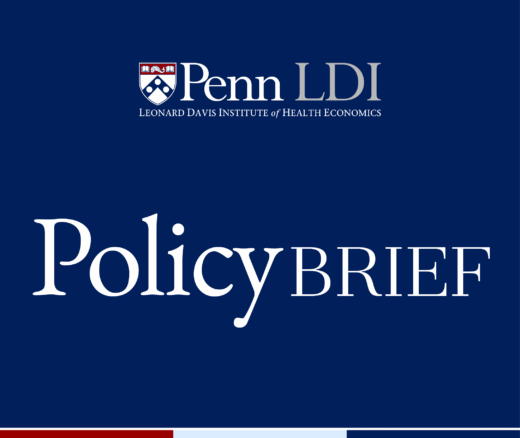
Get a Second Opinion: Generative AI Produces Inconsistent Medical Recommendations
Study of Six Large Language Models Found Big Differences in Responses to Clinical Scenarios
Health Care Access & Coverage | Health Equity
News | Video
This article has been corrected.
As hospital consolidations swept the country over the last three decades, their executives predicted the moves would produce lower costs. But decades of health services research focused on the actual results of this trend have found the opposite. Consolidation has consistently produced higher care prices. Nevertheless in 2023, health care merger mania not only continues, but is expanding in increasingly complicated and more costly ways. Why is this happening in a nation that has otherwise made the reigning in of runaway health care costs a top economic priority?
That question was the subject of a University of Pennsylvania Leonard Davis Institute of Health Economics’ virtual seminar that brought together four top authorities to review the benefits, disadvantages, and trajectory of ongoing health care industry consolidations.
“Health care consolidation impacts every aspect of the health care system,” said seminar moderator and LDI Director of Policy David Grande, MD, MPA. “It’s not a new trend but it has rapidly accelerated. There were 1,887 hospital mergers announced between 1998 through the end of 2021, according to the American Hospital Association.”

“There are also indications that consolidation will reduce access to health care for the most vulnerable populations through hospital closures and higher prices in highly consolidated markets,” continued Grande. “Adding to that is the fact that private equity has entered the market amid predictions that the stresses of the COVID-19 pandemic will accelerate the pace of consolidation.”
Grande invited the four panelists to offer their sense of the situation. They were James C. Capretta, MA, Senior Fellow, and Milton Friedman Chair at the American Enterprise Institute (AEI); Leemore Dafny, PhD, Professor of Business Administration at the Harvard Business School and former Deputy Director for Health Care and Antitrust in the Federal Trade Commission’s (FTC) Bureau of Economics; Mark Seidman, JD, FTC Assistant Director; and Lois Uttley, MPP, former Senior Advisor at the Hospital Equity and Accountability Project.
Perhaps the least mentioned issue in the reams of press coverage about the consolidation debate over the years has been its impact on health care equity.

“The unfortunate reality is that more than 25 years of market-driven health facility consolidation has really left too many communities across the U.S. without timely access to needed care,” said Uttley, who works with vulnerable communities to analyze hospital and public policies related to health care. “Residents of urban neighborhoods of color and rural areas have suffered a lot as independent hospitals have closed or joined big health systems. Acquiring systems often move to close services like intensive care, labor and delivery, psychiatric care, and cardiac surgery. It forces people to travel out of their communities and poses really serious navigation issues for patients, especially those who are disabled, elderly, non-English speaking, and without their own cars.”
“When the acquiring system is one of the private equity firms now increasingly active in the health sector, a community hospital may end up being stripped of its assets, loaded up with debt, and forced to lay off staff, leaving its patients with what amounts to just a shell of a hospital,” said Uttley.
In 2021 when the Biden Administration ordered expanded FTC efforts to promote competition rather than mergers across the health care industry, it reported that the 10 largest health care systems already controlled 25% of the national market.
The FTC’s Seidman explained some of the difficulties the regulatory agency has encountered in its legal efforts to slow the trend.

“If you go back to the 1990s,” said Seidman, “the FTC and the Department of Justice really had a very hard time blocking hospital mergers. Judges seemed skeptical that hospitals would ever act anti-competitively—that those institutions would ever raise prices, or reduce services to their patients, especially with nonprofit hospitals. So, the FTC took a step back as economists studied the effect of hospital mergers on prices and were able to show empirically that even nonprofit hospitals took advantage of the market power when they could. That history led to a resurgence in hospital merger enforcement.”
Seidman also noted that those enforcement efforts are “incredibly intensive work and the amount of resources that we’re allocated by Congress has a direct effect on the amount of work we’re able to do and the number of mergers we’re able to look at and litigate. Going to court is an incredibly expensive and intensive process,” he said.
Harvard’s Dafny recently testified before the U.S. House Committee on the Judiciary’s Subcommittee on Antitrust, Commercial and Administrative Law that “Studies show horizontal [or same-market] consolidation results in higher prices for hospitals. This is also true for physician groups, and for insurance premiums. The evidence on non-horizontal health care mergers, such as mergers across providers or firms in different geographies or service categories, also shows price and spending increases, after hospital systems acquire additional hospitals in the same state, and after hospitals acquire physician practices.”

Dafny amplified her remarks at the Penn seminar, explaining how consolidations are structurally expanding in horizontal, vertical, and cross-market ways. The first refers to mergers of hospitals in the same local market; the second is about the integration of hospitals or insurance companies with large physician practices; and the third relates to hospital systems’ expansion across multiple states and broader geographical regions.
“When rivals merge, prices increase and there’s scant evidence of improvements in the quality of care that patients receive,” said Dafny. “There’s a little bit, but there is also a fair amount of evidence that quality of care decreases.”
AEI’s Capretta agreed that stronger enforcement of anti-consolidation policies is important. But he asked about changes that can be made to encourage new entrants to establish themselves in already heavily consolidated markets to restore some meaningful levels of competition. He also noted the symbiotic relationship between the current U.S. health care reimbursement system and market-dominating institutions that complicate such efforts.
“When you build a big, heavily regulated payment system, driven through a lot of politics and regulatory policy, it does tend to favor incumbents,” Capretta said. “And they work the regulatory system, they work the political system, and that feeds into consolidation and lack of competition.”
And, according to Uttley, those same sprawling consolidated organizational structures can have other kinds of negative impacts on patient health and wellbeing—including the restriction of reproductive, gender-affirming, end-of-life, and other kinds of health care.
“When the acquiring health system is a religiously sponsored one, then community hospitals are often forced to eliminate or restrict key reproductive health services, pregnancy emergency care, prohibit gender affirming care, and certain end-of-life options,” she said. “Many people are not aware now that five of the 10 largest private health systems in the nation are operated by religiously sponsored health systems, four of them Catholic and one Seventh-Day Adventist. All these systems use doctrine to restrict care.”

Grande raised the rarely discussed issue of whether the Centers for Medicare and Medicaid Services’ (CMS) current move toward value-based alternative payment models could ultimately drive smaller hospitals to become more aggressive in seeking mergers with larger organizations to survive.
Capretta acknowledged the difficulties smaller institutions may face as payment innovation progresses across the industry.
“The motivation for alternative payments is to help the provider community get incentives lined up toward efficiency and paying for a set of services bundled up or as a total cost of care for a whole population,” Capretta said. “The idea is that if you work together across the provider community, you might be able to find efficiencies and other ways of changing the care process to make it more efficient. But to be able to participate in such a thing, the cost of entry can be high. You’ve got to be able to track the patients, accept risk, and have enough of a population so that if a few very expensive patients come in, you’re not really out of a lot of money.”
“The size of the health system can have a material effect on its ability to absorb this kind of payment model,” Capretta continued. “I think there’s an opportunity to think about additional alternative payment models that are more micro and manageable at the physician practice level and not so big that everybody is driven toward major systems.
“Financial incentives are really the key to all of this because it’s going to be very difficult to regulate the outcome you want,” said Capretta.” Regulation lets you do some things like constrain, cap, or prevent, but you can’t create a hospital or make one come into a market and start serving patients through a public policy. You have to have the right financial incentives and that means encouraging more entry, more participation, more players and more supply across the board.”
~ ~ ~
Correction: Our original report said that between 1998 and the end of 2021, mergers reduced the number of hospitals from 8,000 down to around just over 6,000. That was not correct and has been removed. The AHA Annual Survey reports that there were a total of 6,021 hospitals in 1998 and 6,129 in 2021. A merger does not necessarily result in the elimination of one of the entities involved in the transaction.
This event was supported by the Charles C. Leighton, MD Memorial Lecture Fund.


Study of Six Large Language Models Found Big Differences in Responses to Clinical Scenarios

A Major Federal Value-Based Purchasing Program Was Designed to Cut Hospital Readmissions. LDI Fellows Say the Incentives Are Too Small to Drive Real Change

Penn LDI’s Antonia Villarruel and 10 Other Authors Map Social Determinants Across Multiple Racial and Ethnic Groups

Memo: Response to Request for Analysis

Lessons from the Past, Imperatives for the Future

An LDI Expert Offers Five Cost Control Measures As Congress Continues Its Affordability Debate